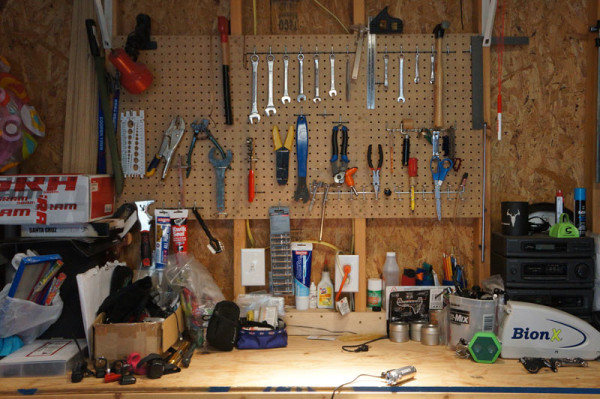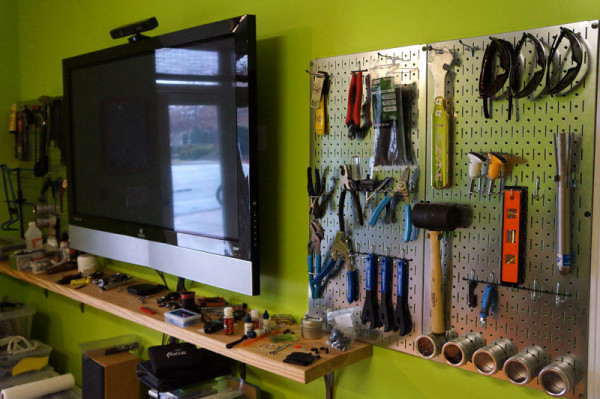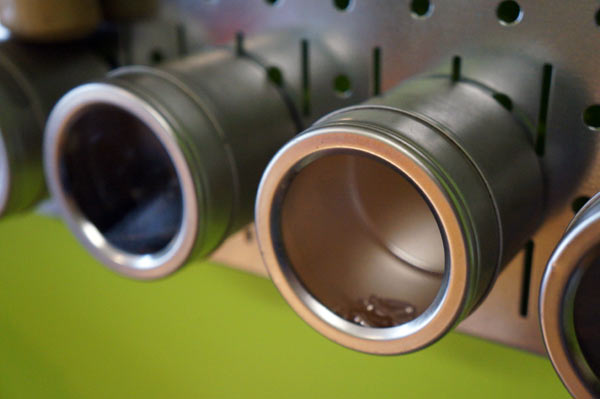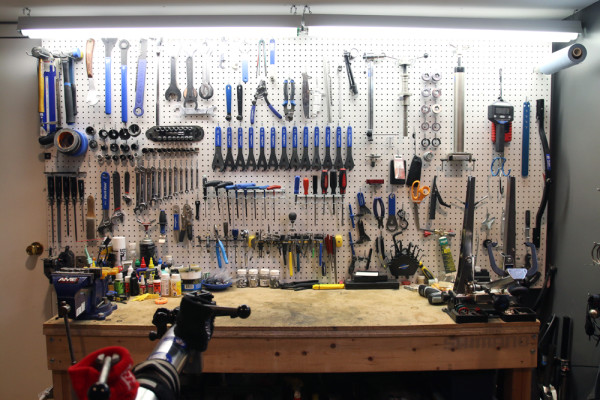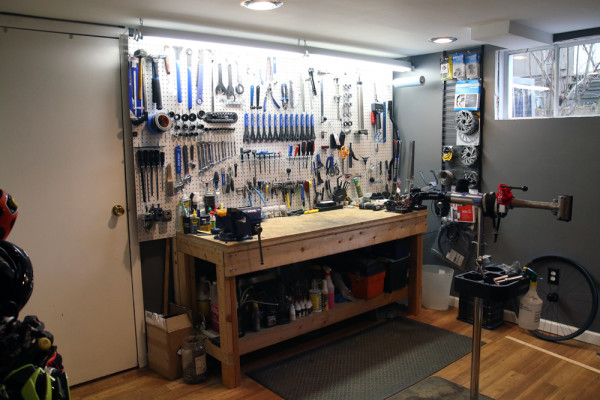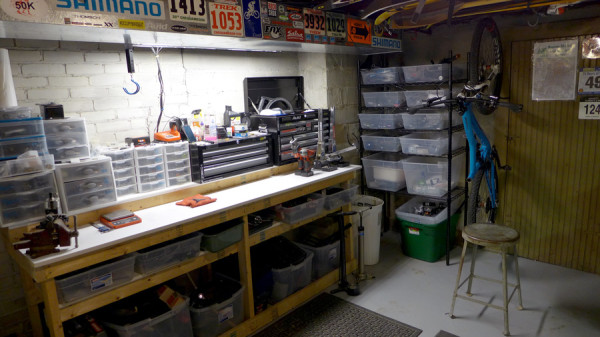
As a cycling enthusiast, once you venture into the realm of owning more than a few bikes, it usually becomes time to work on them yourself. In this series, we are going to cover the idea of building your own home workshop, matched to the mechanical skills or limits that you have. Most of us will have a limit to the work or maintenance that we want to perform ourselves, leaving the more difficult tasks to the professionals that have the right tools. As we move through the series, we will cover all the areas of bike assembly and maintenance, and the tools needed for each task.
Part 1 will be about the primary tool of a home shop, a space to do the work. Working on a dirty bike in the kitchen will probably not win you any favors from your housemates, so it is important first to establish a place to set up shop. Jump in to the story as we discuss space, work benches, and storage…

Space is the primary thing you need. Having a space for your bike work is essential to keeping tools and bike parts in order, and keeping the rest of your life free from dirt and grease. Most people will choose a garage or a basement, since those areas are better for getting dirty, and you probably store your bike there already. Since my garage is sub-freezing for half the year, I use my basement for a shop. Cycling is a much more compact hobby than say, assembling a kit airplane, so a lot of space is not needed. About 100 square feet is sufficient, my particular area is 12ft wide by 9 feet deep.
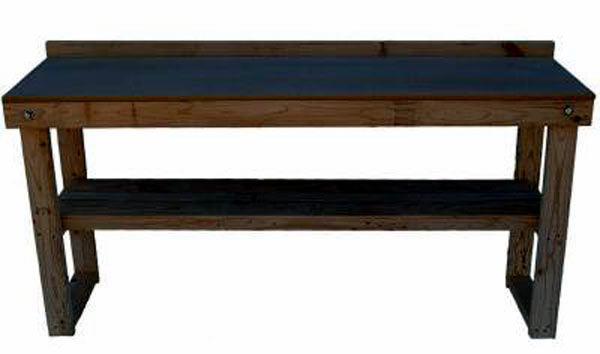
A good workbench is a great place to start. A simple bench made from 2x4s is sufficient for bike work, and reasonably affordable. My bench shown above cost around $100, and is 8 feet long, since most of the material is sold in 8 foot sections. It is built with white melamine coated MDF panels for the surface, and self-tapping Spax screws, and it took about 2 hours to create. If you don’t want to venture into woodworking, there are also kits available at most home improvement stores, such as the one shown above that is available from the Home Depot for $69.97. If your walls and/or landlords allow, screwing the table into the wall studs behind it keeps everything very stable.
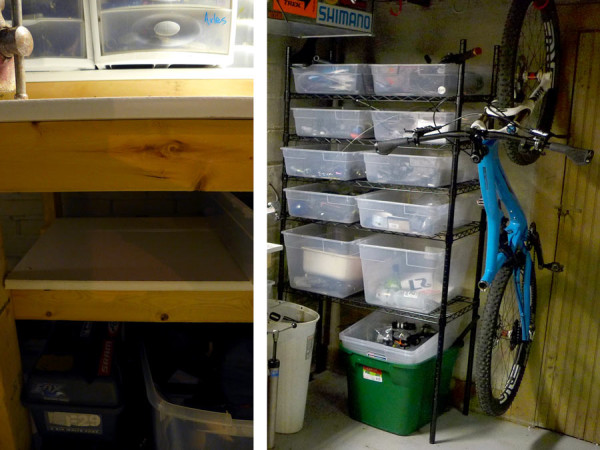
For storage of parts and gear, Sterilite or Rubbermaid containers work really well. I use clear ones so you can see what is inside them easier. Under the workbench it is easy to add a shelf for the containers, and if more space is needed, inexpensive wire shelving is available from most home improvement or big box stores. To store your bikes, simple vinyl covered hooks also available from these stores easily screw into a wall or ceiling to hang your bikes out of the way.
Peg board is the other storage solution and keeps tools ready for action. By placing your most used items in easy reach, you can be way, way more efficient. Tyler’s work spaces use both options, the standard pressed “wood” pegboard that comes in as large as 4′ x 8′ sheets at the hardware store…
…and the more elegant galvanized steel ones that allow for magnetic storage pods to be used. You’ll find it at Sears occasionally, but your best bet is online with (surprisingly, considering the weight) free shipping.
Spice rack bins make great containers for small bits like cable ferrules, and the magnetic backs keep them in place.
Owing to his years a bike mechanic, Zach’s workspace is on the more advanced end of the spectrum, but still within reach of the average home mechanic. Due to space constraints, pressed peg board was used for the tool rack since it could be easily cut to fit. The workbench is probably overbuilt with two layers of 1/2″ ply and a third layer of 1/2″ MDF for a work top, but at this point it has survived two houses and one move.
Ample light is very important especially when working with small parts. One or two inexpensive fluorescent light fixtures from the local hardware store will do the trick. Zach runs two 4′ fixtures side by side, plugged into a powerstrip on the side his work bench. That provides extra outlets should you need them for powertools, charging Di2 bikes, etc. and also provides a single on/off switch for both lights.
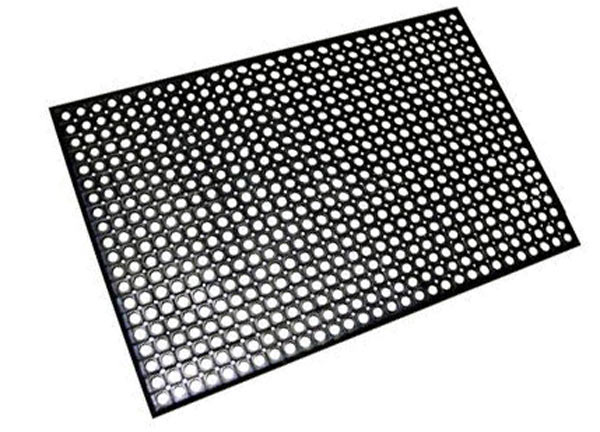
Finally, make sure working in the space is comfortable. If you have a concrete floor like most garages and basements, industrial anti-fatigue mats are also available from most home improvement stores, make it easier to stand for a while, insulate your feet from the cold floor, and prevent that dropped bolt from rolling off into Narnia. If you don’t want all the holes, interlocking gym floor mats can be found at Target, Wal-Mart, Sears and sporting goods stores and make a great option if you happen to have wood floors you don’t want ruined by any grease or oil drippings.
Have a good opinion on setting up a workshop space? Want to share your space with Bikerumor readers? We will be continuing to mold this series based on what others are doing as well, so send your feedback to tim@bikerumor.com.
Check back for Part 2 where we will dive into basic tools for basic repairs.
If you haven’t seen them already, make to check out all of the other installments from our Home Workshop Series!
